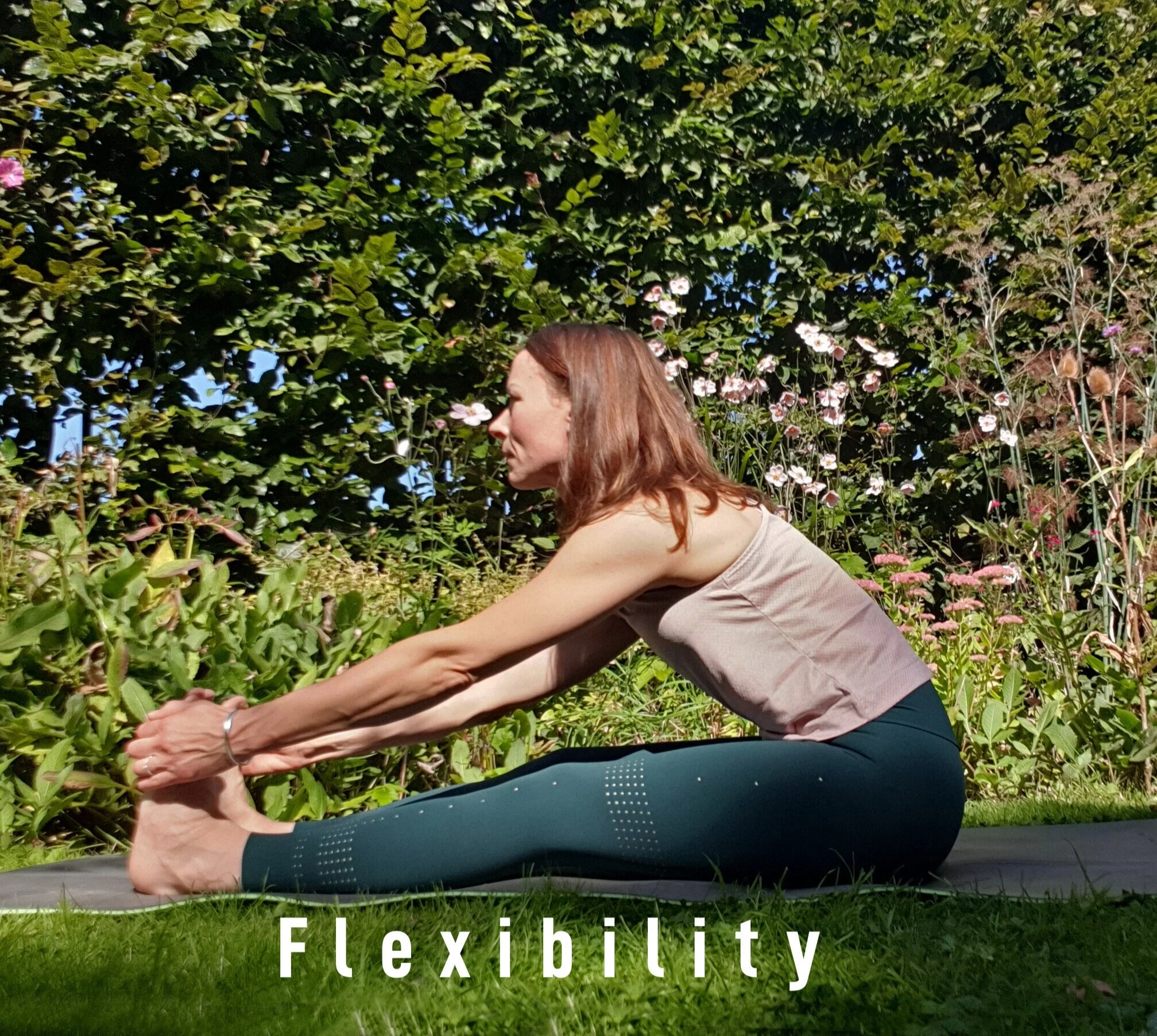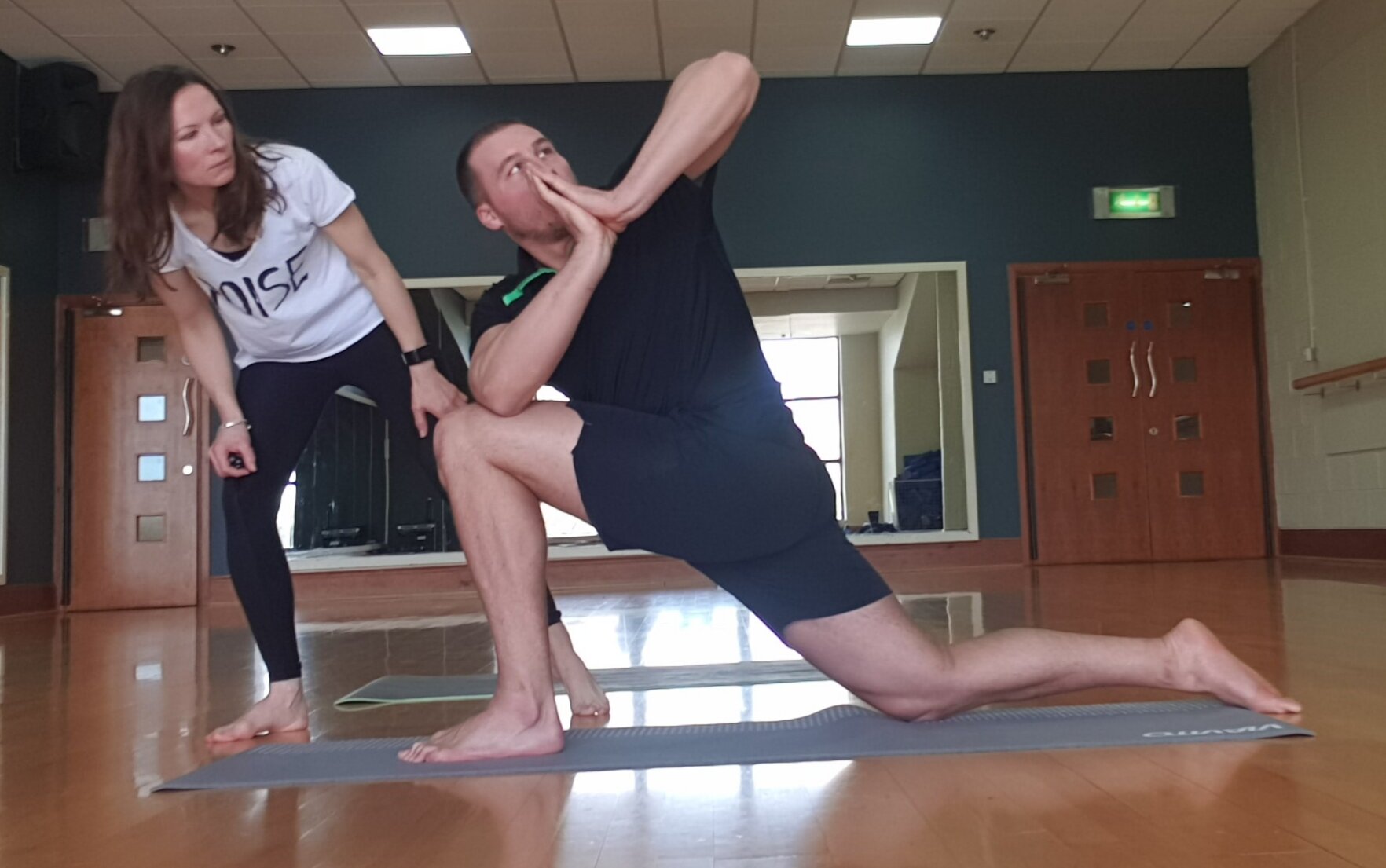What is flexibility, why is it so important for sport and how can yoga help..?
One of the main reasons for investing in some yoga as part of your fitness and training regime is to become more flexible. But why is this important...and why is it so often misinterpreted?
What is flexibility?
Flexibility by definition refers to the range of motion/movement (ROM) in a joint or group of joints and the ability to move effectively through that complete range of motion (ROM = the full movement potential of a joint). Increasing the muscular elasticity of a joint’s ROM through exercises like stretching, can improve a person’s flexibility and if utilised correctly, yoga can provide a sensible platform to do this within the realms of healthy joint mobility.
However, we are all individuals and consequently have differences in the length of our multi-joint muscles, so some of us are naturally more flexible than others, or have more flexibility in certain areas. As well as anatomical differences, there will also be limitations placed on our natural flexibility based on age (we generally become less flexible as we get older), gender (women tend to be more flexible than men due to less muscle mass, and more oestrogen), and/or our training background. It is easier to maintain flexibility than to improve or increase it, so the earlier you can start incorporating some stretching and other activities to promote flexibility into your training regime - in a safe and gradual way - the less these factors become a hindrance.
Why flexibility is important for sports performance (and movement in general)
There are many reasons why becoming more flexible should be an integral part of a training regime.
Flexibility:
provides greater movement and better functioning muscles, which ensure the entire kinetic chain functions properly during performance.
reduces the risk of injury as connective tissue is less likely to tear, even in unexpected situations, if it’s stretched regularly.
ensures our range of motion is maximised.
maintains joint stability.
allows us to move comfortably and pain-free.
improves posture and balance, allowing us to carry out movement more easily and efficiently.
increases our strength, as the muscles are at the correct tension to support us and our movements.
Different types of stretching
There are three types of stretching, which can all be beneficial:
Static (or Static-Active) stretching/flexibility: is where you move into a single position that lengthens a target muscle and hold it, by using one muscle or set of muscles to stretch an opposing muscle or muscle groups. For instance, in an unassisted quadricep stretch, when the knee is in flexion, with your heel coming towards your glutes, your hamstrings or the agonists in this posture (those muscles dominant in creating the movement) alongside the synergists (the muscles stabilising the joints during this posture, in this case the glutes) stretch the quadricep or antagonist (the opposing muscle). Static stretching always stays within a person’s current range of motion, meaning they are less likely to overstretch and cause strain or injury. However, you do need additional strength to be able to hold a stretch in this way for enough length of time to make it worthwhile. In yoga, some standing balances such as Warrior III or Half Moon are examples of this kind of stretch.
Dynamic (or Kinetic) stretching/flexibility: is moving in and out of a position to lengthen a target muscle, utilising the full range of motion of a joint, at either at a slow or faster pace, usually reflecting a functional activity. This is the best version of stretching to increase range of motion, and to warm up both the nervous system and the muscles. It also incorporates the technique known as Active Isolated Stretching (AIS), which is moving the joint through its complete range of motion, holding it at its furthest stretch for a brief moment, before returning to the start and then repeating for a series of counts. An example of this type of stretching in yoga is a repetitive flow between two linked poses, for instance from chair to mountain pose and repeat.
Static-Passive (or Passive) stretching/flexibility: is creating flexibility in your muscles whilst they are in a more relaxed state, using props or your own body weight to create light resistance. This is where yoga breathing comes into its own, as a focussed technique can help relax the muscle group you are trying to stretch, and is the methodology used in a yin yoga practice: holding a few key postures for a longer time, allowing the muscles to contract less, and improve flexibility. It is more normal to do this kind of flexibility training in a stand-alone class, but it is absolutely essential to be completed warmed-up first, and not do this kind of stretching after a heavy weights session. A great yoga posture for passive stretching is reclining pigeon/swan pose, which really works into hip flexibility, as well as stretching through the sometimes niggly IT (iliotibial) band and the TFL (tensor fasciae latae) muscle, that both run down the outer thigh.
Increasing flexibility and how to do it safely
Working with one of my clients, Jon - a powerlifter and Strongman competitor.
There are general stretching exercises and yoga postures that can benefit everyone, and these can be incorporated into a regular yoga class, or as part of a warm-up or warm-down routine. However, in the case of most specific sports training, a different sequence of postures/stretches will be needed to target certain muscle groups utilised for that sport during the warm-up, which is stretching prior to physical activity, to prepare your muscles for training, and the warm-down, which is stretching after exercise to help prevent injuries and speed up recovery. For example, if you are a runner, you will need to focus on gentle stretching and movement through your hamstrings, hip-area, quads and calves during a warm-up, and on the warm-down, more intensive stretching through the same areas, with secondary stretches around the shoulder girdle, lower back and lateral areas of the torso, especially through the obliques.
However, once the term ‘runner’ become more defined e.g. a competitive marathon runner or an elite sprinter, these sub-category disciplines are very different, so each athlete training in these areas will need a bespoke flexibility training programme that reflects their own personal anatomy, their training and injury history and their performance needs, as well as complementing everything they are doing with their other health & training providers such as their coaches, physiotherapists etc. This is why most yoga for sport instructors work one-to-one with their clients, rather than hold general classes. Whilst the latter are perfectly beneficial for the average active person, gym bunny etc. the level of specific need for more elite athletes requires a more focussed and bespoke methodology in order to have maximum benefit, as well as a collaborative approach with their aforementioned health & training providers. Even carrying out flexibility training with a team in the same sport can be challenging within a class environment. Although generic stretching and yoga postures aimed at their specific sport will have some positive influence, sports such as football, and rugby in particular, will have players required to do very distinct things, which involve moving differently from one another, using their bodies in a myriad ways, often shown in the range of body types that make up that team. This means at the very least dividing the team into distinct sections for flexibility training, or treating them 1:1 as with other athletes.
The key things to remember when wanting to safely increase your flexibility are:
Stick to dynamic stretching (see above) when you are warming-up your body prior to exercise, training or activity
Flexibility increases over time, and everyone is different. Don't try and push yourself beyond your limit/range of motion too soon, especially if you are not fully warmed-up
Don't bounce into a stretch (sometimes called ballistic stretching). The jerky and erratic nature of this method can cause injury, rather than increase flexibility, especially if done from a standing start.
Learn how to breathe properly (silly though this sounds, this is a whole other topic!) as one of the many advantages of breath technique is the ability to relax muscle, which will help improve flexibility, especially when applying the passive stretching approach.
Flexibility training is not a competitive environment. As mentioned above, natural flexibility varies enormously between individuals based on a number of factors. It is not about trying to tie yourself in a knot, or reaching further than everyone else in the room, but increasing your own flexibility safely and beneficially, for your body’s limits and your sport.
Hypermobility - there is such a thing as too much flexibility
Historic photo of a contortionist doing a back-bend.
Being supple and flexible is often associated with people contorting their bodies into positions way beyond the normal range of motion for a joint. You just have to type ‘flexibility’ or even ‘yoga’ into a search engine or Instagram and images like this sepia photograph on the left are everywhere. I personally think that portraying yoga and flexibility in this way is misleading and off-putting for many people who would benefit from increased flexibility. When you cannot touch your toes, or suffer with arthritis etc. these kind of images make yoga looks inaccessible to anyone who can’t place the soles of their feet on their head, or similar…!
The ability to move joints beyond their usual range of motion is actually a medical condition called hypermobility (also called 'double-jointed') and is due to a person having weak connective tissue around some or all of their joints. This creates more vulnerability in these joints, making them more susceptible to injury, dislocation and pain. It tends to be a hereditary condition, is more common in younger people, especially woman who (as mentioned) tend to be naturally more flexible. In many cases, being hypermobile doesn't cause any issues and certain sports such as gymnastics, figure-skating and synchronised swimming almost require people to have this trait, although many top sports people in these areas also started training at a very young age, again when flexibility is at its optimum.
However, when it comes to high-impact sports, such as running, skiing, football, basketball etc. - any sport where there is frequent wear and trauma to weight-bearing joints, such as knees and hips - too much flexibility isn’t helpful and can cause problems due to this weaker connective tissue present. If hypermobility is present in multiple, major joints, it can also lead to over-compensation and added pressure on other, ‘normal’ joints. For example, if someone’s hip and ankle joints are hypermobile, there will be increased pressure and possibly pain on the knee joints, as the only stable joint in this chain.
It is important to understand the condition and learn to rein in some of the range of motion, as well as build additional strength, to manage this vulnerability . I have hypermobility in some of my finger and thumb joints, and wasn’t aware of this for many years, so had been doing all sorts of crazy press-ups on finger-tips etc, but having clocked up a few decades (!), my knuckles are now starting to click, get stuck in one position and have a bit of pain, so it is really important to heed my own advice from now on, although my hypermobility is only minor.
End note
Introducing a flexibility regime into your training programme is SO important for all the reasons listed above. To quote Ed Leigh, ex-professional snowboarder and presenter on BBC2’s Ski Sunday, who I think summed up utilising yoga in sports performance training beautifully:
“I’m a big fan of yoga. It blends strength and flexibility. Strength for when things are going well and flexibility for when things go wrong - you bend, you don’t break”.
However, it is important to ensure your flexibility programme works for your sport: how you use your body, how you need to move, the demands on your joints and your overall anatomy/body-type. This is why yoga for sport is not a ‘one-size-fits-all’ approach, and why us specialists work in conjunction with the rest of an athlete’s health and training providers to maximise the benefits for both performance and injury prevention, so people can move better, for longer at the top of their game and beyond…



